#VFR and IFR
Explore tagged Tumblr posts
Text

Learn the differences between VFR and IFR in aviation. Understand how pilots navigate using Visual Flight Rules (VFR) and Instrument Flight Rules (IFR) for safe flying.
0 notes
Link
In the article "Flying in Alaska — The Last Frontier" published on The Armory Life and written by Will Dabbs, MD, the author recounts his experiences as a helicopter pilot stationed in Alaska during his military service. Hoping for an assignment in Europe, Dabbs was instead sent to Alaska, where the challenging weather and rugged terrain became his new reality. He describes the transformative experience of flying CH-47D Chinook helicopters across vast, pristine landscapes, including daring missions and breathtaking natural beauty. The narrative highlights the harsh conditions and unpredictable wildlife, such as wolves and grizzly bears, and the camaraderie formed within his unit. Dabbs shares stories of unique survival exercises and historical aircraft wrecks encountered, ultimately expressing both the hardships and the profound impact of serving in America's last frontier.
#Flying in Alaska#The Last Frontier#Alaskan aviation#bush pilots#Piper Super Cub#Cessna 180#floatplane#Alaska Range#Denali#remote airstrips#rural communities#survival equipment#flight safety#weather challenges#fly-in fishing#hunting camps#wildlife spotting#Federal Aviation Administration (FAA)#VFR (Visual Flight Rules)#IFR (Instrument Flight Rules)#aviation fuel#aviation maintenance#aviation insurance.
0 notes
Text
Fixing the AWC URL on older MetarMaps
My CFI asked me if I could get the school’s METARmaps display board working again as it stopped working once the Aviation Weather site migrated to the new platform. There were many threads on the topic including an official post from METARmaps offering a paid upgrade to fix the problem without any instructions on how to fix it yourself. This is probably a good option for many, but I’ll throw a…

View On WordPress
#AIRMET#Aviation Weather#AviationWeather.gov#IFR#IMC#KLKU#LIFR#METAR#METARmaps#PIREP#Raspberry Pi#SIGMET#VFR
0 notes
Text

Watching fall roll in from above 🌥
#aviation#autumn#autumn sky#fall vibes#plane#flying#travel#flight school#study hard#blue vibes#ifr#vfr#view from the top#airplane#airport#cloudy sky#my photos#original content
0 notes
Text
Delicate (Jake's Version)


31 - Jake's Dog
Pairing: Jake 'Hangman' Seresin x OFC Samantha Kazansky
Rating: EXPLICIT (MDNI!)
Warnings: SMUT, oral (m receiving), angsty!Jake, angry!Jake, stressed AF!Jake, panic attack, argueing, make up oral? protective/aggressive dog behavior from Ballast
A/N: SMUT, sort of...angsty!Jakey and Sam because why not, and Ballast has some shit to sort out with his human. Also Jake is about to kill Rooster again. Also, I researched for like a half and hour about Air Traffic control and other jet related things. I did my best. Sorry if it's crap.
(note: aus is the command in German for ‘out’ or ‘let go’)
Again, thank y'all for reblogging, commenting, liking, etc. I really appreciate it tons! <3
Tags: @mrsevans90 @djs8891 @gpsmississippihippie @barnesboo1967 @dizzybee03 @coloraturadiva @kmc1989 @dizzybee03 @khouse712 @kaleysbookshelf @rootedinrevisions @crossskylinesandcontrails
It was the first time in a long time that Jake’s nerves were on fire as he strapped himself into the cockpit of the jet . His jet. He was sweating in his flight suit. It felt great to put the helmet back on again. It had felt even better when he went through the NATOPs competency test. He had aced the simulator, and the written test on the manual, and now was his first day officially back up in the air.
Maverick climbed up the ladder and patted Jake on the back. “You’ll do great. It’s just a straight shot, easy flight.” Mav said, tapping his hand on the outside of the jet.
“I thought you were going up with me?” Jake asked, and Maverick shook his head.
“No. Rooster is. He needs some more hours before he can apply to be a tester.”
“Tester?”
“He wants to do what I've been doing. There's an opening at Oceana for it.”
“So he's supervising me?”
“In a manner of speaking, yes, but only for emergency purposes. You know how this goes, Jake. You've done these flights a million times. Standard Op. Enjoy yourself.”
Jake would most certainly enjoy himself, as long as Rooster kept his damn mouth shut. His breath quickened and he felt his head spin slightly. He brushed the feeling away as they signaled for him to taxi.
“NKX Tower, Hangman F/A-18, East Ramp, VFR/IFR Composite Loop, Standard Op.” Jake said, and he suddenly felt at ease.
“Hangman F/A-18, NKX Tower, taxi to Runway 3.” The air traffic controller responded.
“NKX Tower, Hangman F/A-18, Runway 3, ready for takeoff.” Jake took a deep breath after and a huge smile crept across his lips.
“Hangman F/A-18, Runway 3, you are cleared for takeoff. Glad to have you back!” The tower replied and he could hear some cheering in the background.
“Thanks. Hangman F/A-18, Runway 3, cleared for takeoff.” Jake confirmed, saluting to the ground crew. He’d nearly forgotten how much he was pushed back into the seat as the jet sped down the runway, the downward force as the jet lifted off as he pulled back on the stick, and the feeling of absolute euphoria that spread throughout his entire body as he felt him relax as the blue of the sky unfurled before him. Besides when he was with Sam, this was his home.
Once up in the air, he heard chatter over the radio, of Rooster taking off. Jake was already over fifty miles out at this point, comfortably cruising at around three hundred knots. He knew Rooster was supposed to be his back up, his wingman, but he doubted he was going to catch up.
“Hey Hangman. You look good up here.” He heard Rooster say through the radio, knowing he was somewhere far behind him.
“I am good. Rooster. I’m very good. Nice to be back up here.” Jake murmured, trying his best to ignore Rooster but failing.
“Have a nice vacation?” Rooster asked casually.
“Yeah.” Jake's response was short, making it clear he wasn't interested in talking.
“How’s the office work?” Rooster asked, almost hinting at humor.
“It's shit. Been waiting to get back up here.” Jake was getting annoyed now, wishing Rooster would just shut the hell up.
“How's...Sammy?” He asked and Jake's cheeks heated. He felt anger bubble up.
“Samantha is fine.” Jake said through gritted teeth.
“Aright, don't get pissy.” Rooster chuckled.
“I'll get as pissy as I want when you talk about my girl .” Jake growled.
“Must've been nice, while we we're all busting our asses, Sammy was your personal nurse, and whatever else you used her for. You decide on a date for the wedding yet? You are still getting married right? You didn't scare her off?”
“Rooster... shut the fuck up .” Jake nearly yells into the radio. For the rest of the flight, Jake was silent as the grave. On the landing, Jake headed in first, fumbling with the stick as he landed. He lost his grip for a millisecond as the landing gear was making contact with the runway, The jet touched down hard, the front gear snagging slightly on the tarmac and sending a jolt through Jake's entire body.
When he taxied off the runway, his heart was pounding in his chest and he hadn't realized just how hot he was in his flight suit. When he climbed down out of his jet, he realized just how much his head was spinning, as he lost his balance coming down off the ladder. One of the ground crew happened to notice and asked Jake if he was okay. He just murmured ‘yeah, fine,’ and headed down the tarmac, toward the locker room.
“Fucked the landing, huh, Bagman?” Rooster yelled, a loud laugh leaving his stupid mouth. Jake shot a middle finger back at him, continuing toward the locker room.
Jake nearly ripped his flight suit off. There was no one around, so when he removed his t-shirt, he threw it and his boxer briefs harshly against his locker, before grabbing his towel and heading to the shower. He just needed to rinse himself off. His brain was going a million miles a minute. His heart was fucking jumping out of his chest. His breath was coming out hard from his nostrils. He was fucking angry.
Rooster just continued to get under his skin and as he let the warm water wash over him, his mind traveled to Sam. Did he tell her what Rooster said? Surely he shouldn’t. He shouldn’t add to her stress, now knowing that she was pregnant. It had been a huge relief, but it had added so much more on top of everything. Especially where they both agreed on a quick wedding. Jake almost suggested just going to the courthouse and taking Javy as a witness. Or Nat. But he knew Sam wouldn’t want that. Sam wanted a beautiful day with friends and family.
Jake owed it to her to make the day as nice as possible. Jake placed his hands on the wall of the shower, letting his head drop, his tags jingling. All he could think of was how the one mistake he made at the end of the flight, losing his grip for a second, could’ve killed him. Then where would Sam and his kid be? Without him, that’s where.
Jake’s heart kept up its pace, through the rest of his shower, through drying himself off, dressing himself in a clean shirt and his khakis, with his cowboy boots. He needed to stop at his office for something and then he just wanted to go home. He was pissed off, and he knew what was building inside of him. He thought for sure he had been through all the mental strife, but now it seemed he wasn’t.
One bad day and Jake goes back to a crumbling mess in the truck on the way home. His heart felt like it was going to pop out of his chest. He was sweating again, nearly through his shirt and his muscles ached more than he’d ever felt them ache before. It was almost worse than when he came back home. He needed to get his emotions in check before he stepped inside, for fear of what he might say in a moment of high anxiety.
🛩️⚓🛩️
Jake had never been scared of a dog, and he never thought his own would be the one he’d be scared of, however, he couldn’t blame Ballast.
Jake was having a panic attack. A pretty drawn out one too. It ebbed back and forth in intensity over the course of the day. He’d felt it beginning when he’d stepped on base that morning. He felt it come to a head when he stepped in the door at home. Sam had just found out she was pregnant, after they’d finally come home from Oklahoma. She was sitting at the kitchen island sifting through some mail.
“How was it?” She asked and he nodded. Jake was silent and this had been bugging Sam immensely. They had gone through all of the trouble of talking out nearly every aspect of their relationship and then it seemed that Jake had shut down again. She knew it didn’t have anything to do with her, that it was all stress and related to his job, but she felt like part of it was her being pregnant. She hadn't wanted that to change their relationship, but it was inevitable that it would.
“It’d be nice if you talked to me...” Sam said and Jake felt anger boil up inside him. They’d been arguing on and off the past couple of days, trying to figure out where they were going to settle. An argument that he thought they had hashed out before they came home, but since finding out Sam was actually pregnant, it seemed like she’d developed a bit of a short fuse and quite suddenly. Jake knew it was the hormones, and Sam admitted as such. She wanted to stay in California, but it was Jake who, once he’d gotten a taste of his old country life, he wanted it back so bad, and Sam just wasn’t budging.
“I will when it’s not an argument.” Jake affirmed and Sam shook her head in disbelief.
“You’re still mad at me for wanting to stay here? Jake, this is what I know and it’s where I’m comfortable...”
“Yes, and you’re being fucking selfish! I’m supposed to be where I’m comfortable while I’m getting over bein’ fuckin’ tortured half to death and it’s not here! I’m not okay here anymore! I knew I wouldn’t be!” Jake had raised his voice, slamming his hand on the counter, and he immediately regretted it, as a flash of black charged into the kitchen. He jumped back and Ballast stood crouched in front of Sam, growling.
At Jake .
No...he was snarling at Jake, drool dripping from his mouth as he barked fiercely at the man who fed him and walked him daily. The man who taught him every command, everything that the dog knew. Jake noticed just how sharp the dog’s canines were then. He knew Ballast was fiercely protective of Sam, and Jake had made the mistake of showing physical aggression, and while he didn’t mean it at Sam, Ballast thought he did. In fact, Ballast was so sure that Jake might hurt Sam, that he began to step toward Jake.
“Ballast, no!” Sam yelled, going to grab the dog’s collar, but Jake stopped her, putting his hand up. He was afraid Ballast might mistakenly take that as a cue to actually attack Jake now that he was locked in guard mode.
“Ballast, aus .” He said sternly and the dog growled and laid at Sam’s feet. The dog wasn’t convinced. He stood again and snarled at Jake once more, barking several times before baring his teeth again.
“BALLAST. AUS .” Jake lowered and deepened his voice and pointed toward the living room. Ballast lowered his ears and his head and slinked around Jake and into the other room. The dog stood at the threshold, ready to go after his handler again if he needed to. Jake was careful, stepping toward Sam but keeping an eye on Ballast. The dog growled as Jake’s hands wrapped around Sam’s waist, but he recognized that Jake’s intentions were pure, not aggressive at all. Ballast laid down and placed his head on his paws, still focused on Jake, but calm now.
“He’s never done that before, Jake. What the hell was that?” Sam asked, hugging him tightly.
“He’s only doing what I trained him to do. He thought I was going to hurt you...or something. You know I wasn’t, right?” Jake asked, leaning down to kiss her. She nodded.
“Of course you weren’t. I’m sorry. I keep pushing you and I know you’re stressed being back at work...” Sam admitted and he rubbed her lower back, as he pressed a kiss to her temple.
“I was having another panic attack...I thought I had it under control in the truck before I came in but...” He trailed off.
“I’m so sorry, Jake...maybe...maybe you’re right about moving closer to your brother...at least for a little while.” She conceded, glancing around Jake to see that Ballast was yawning and stretching. He had cooled down and Jake let go of Sam.
“No, I’m sorry I lost my shit. But...even Ballast knows I’m not right in the head...I just feel like I’m regressing for some reason..” He said and he knelt down in front of Sam, taking her hand and kissing the back. He then turned and called his dog over. Ballast wagged his tail and cautiously walked to Jake, then crawled in front of him and rolled over onto his back, showing Jake his belly. Jake reached down and rubbed the dog’s chest and belly and when Ballast rolled back to stand up he was careful as he pushed his nose toward Jake.
“I’m sorry you felt like you had to protect her from me, buddy. It’ll never happen again, I swear.” He said, rubbing the top of Ballast’s head and his ears. The dog welcomed this, panting and reaching to lick Jake’s face. Jake allowed it, even though Ballast had scared him, he still trusted the dog, especially since he was so dutiful to protect Sam. Sam meant more to him than anything.
“Why do you think you’re regressing?” She asked, as Jake stood and placed his arms around her waist. She studied him, seeing concern take over his expression, the sage green of his eyes unsteady.
“I don’t know if I’m stressed from...from you being pregnant...I’m..I’m worried about you.” He, as always when he was unsure, or disquieted, stumbled over his words. But he never did that outside of their little bubble of trust.
“Why are you worried about me?” Sam asked, stretching up to touch her lips to his. She saw a wave of exhaustion pass over him, something that she had noticed had been happening more frequently. Jake’s resolve was so thin and it had been like that for months on end. Sam didn’t know how to fix it either.
“I don’t know, I just am. I’m just...I don’t...I don’t know...” Jake’s voice broke and Sam was quick to pull him into her arms. Ballast was still at his feet and he felt Jake’s emotions heavily, placing his head against his leg. Jake reached down to run his hand over the dog’s head, while pulling Sam in for a needy kiss.
“Well...when you figure out why it’s stressing you out so much, you’ll tell me, right? Because we’re telling each other everything.” Sam’s affirmation as they parted was one that he’d heard enough times now, and he couldn’t even begin to tell her how much it meant to him that they could share the level of vulnerability they had. But sometimes, Jake still didn’t want to delve that deep into his brain. Sometimes he just needed to shut it off.
“Yes. I will, I promise. I just need to think about it. Ugh...I feel like shit. I need to lay down.” He dragged his hand over his face and Sam reached up to cup his cheeks. Her thumbs wiped fresh tears from them, that Jake hadn’t even noticed had been there.
“Here...I’ll come with you.” She said softly, letting her hands drop to his, intertwining their fingers.
“No, no, you keep doing what you were doing.” Jake offered, but Sam wasn’t budging.
“You’re worked up. I can go over that stuff later. I don’t need to do that right now. You need me right now.” She said, his brows knitting as he began to back up. He guided her to the couch, and pulled her over his lap. She straddled him, his hands landing on her waist and winding around to her lower back. Muster jumped up on the couch next to them, putting her face in Jake’s for a moment and then glancing up at Sam. She whined and Sam laughed and shook her head. Jake bit his lip and chuckled as well.
“I think she’s worried about you too.” Jake murmured, reaching up to pat the smaller dog. She allowed it and that made Jake smile wide. “And apparently she likes me now.”
“She’s always liked you. She just hasn’t been okay with you touching her. You needed her consent.” Sam smirked and leaned down to kiss Jake and she could feel his smile spread more.
“Do I still need your consent?” He asked, as Sam pulled away slightly to watch the slyness seep into his smile, and the lust that clouded over his pupils as his lids lowered.
“Muster, Ballast, Rocco, crate.” Sam said softly, and the jingling of tags and cacophony of nails on the floor dissipated as the dogs went to lay down in their kennels. Then there was silence for a beat before Jake’s voice, deep and gravelly, permeated the space between him and Sam.
“You didn’t answer my...”
“No, Jake. You don’t. You can have me...do whatever to me...anywhere, anytime.” Sam’s voice grew sultry and low, as her hands ghosted over his cheeks. “You know that.”
“Mmm, but I feel like I should ask anyway.” He said softly, his breath quickening slightly. “And thank you...”
“For what?” Sam asked, letting her hands travel down to the hem of his shirt.
“Loving me, even when I’m a shit head. Even when I’m struggling. Because I don’t fuckin’ know who would put up with my sorry ass.” Jake’s fingers made their way under the waistband of Sam’s yoga pants, finding she wore no panties. She shifted above him.
“I don’t put up with you. Jake, I don’t feel like I can exist without you. You’re the single best thing that has ever happened to me. And I know we’ve been fighting and we’re at a weird place right now, but after all we’ve been through in the short time we’ve been together, I know we can make it through this. I know we’ll come out the other side. All I keep asking is that you don’t shut back down on me. Please don’t.” Sam inhaled sharply as his warm hands cupped her ass, and squeezed gently.
“I won’t. I don’t mean to. It’s just worked for me in the past. But now, now I know it doesn’t work with you. That’s why I love you. Because you’ve seen me at my worst...and you still want me. And you want kids with me. I never in a million years thought I’d have anyone like you, Sam.” His lips found hers once again, this time in a kiss full of desire and longing. He wanted more. He always wanted more, and she was all too happy to oblige. All too willing to give him what he needed most.
Release.
Sam backed away and slid down to her knees in front of him, her hands resting on his thighs. She waited, looking up expectantly at him. He could see the hunger in her eyes as he unbuckled his belt and pulled it from the loops. As he unbuttoned and unzipped his khakis and slid them down just enough to free his length. And as he ran his fingers gently through her hair, grabbing at the roots and tugging lightly so that she had to make eye contact with him.
“You’re so good to me, Sam. Such a fucking good girl for me.” He purred, then gathered her hair into a ponytail to help her. She rubbed her hands up and down his thighs painfully slow, then took him in her mouth, beginning to pleasure him. He let his head fall back and his jaw worked as he enjoyed every bit of what she did for him.
#glen powell#jake hangman seresin#jake seresin#jake seresin x oc#top gun maverick#top gun fanfiction#top gun#top gun hangman#top gun movie
43 notes
·
View notes
Text
7x03 analysis part 1 — Everything Air Ops
I promised helicopters, so now we get helicopters. I want to look into how Air Operations work in the 9-1-1 universe, in comparison to its real life counterpart in this first part. Then, I will try to figure out the location and intensity of "hurricane Ethel" during the clandestine operation in the second part. And finally, I will prove how risky it is to fly a helicopter into a storm and why Tommy deserves every bit of his Medal of Valor.
Location
Real!LAFD Air Ops operate (Station 114) out of Van Nuys Airport (VNY/KVNY). It's not only one the busiest general aviation airports in the world, it's also smack dab in between major green areas of the city of LA itself.
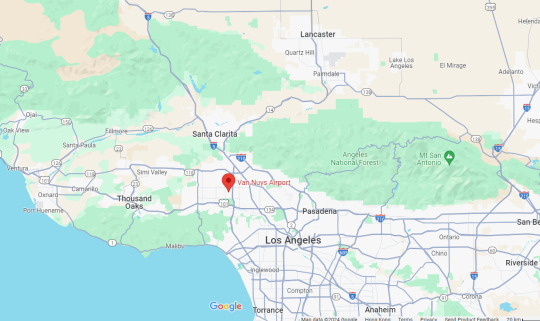
This location makes perfect sense in real life. Air Ops might get the occasional highway car wreck or urban structural fire calls, but most of their missions still consist of wildfire suppression and rural search and rescue. Being based at Van Nuys makes sure they can respond to emergency in a timely fashion.
in the 9-1-1 universe, the LAFD Air Ops are based at "Harbor Station", or Station 217. (Harbor and 217 are the same station, Chimney especially asked if Tommy was still at the 217 in 2x14 when requesting air support, unless the 911-verse LAFD has 2 different air operation units, which I highly doubt.) Obviously it has to be at an airport, because that's where the hangers and helipads are, and going by "harbor" I can only speculate that it's in the Harbor Region of LA.
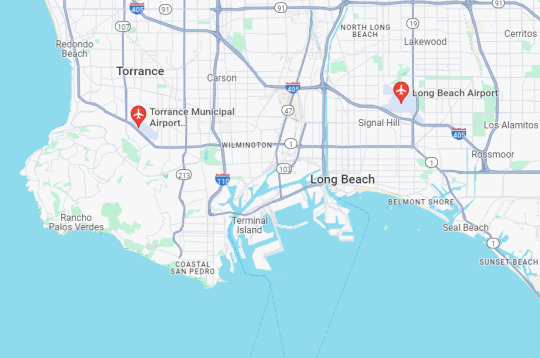
The only non-military airport in the LA Harbor Region is Long Beach Airport (LGB/KLGB), but it's quite a busy commercial airport, probably not a good one to run emergency services from. There's also the Zamperini Field (TOA/KTOA) nearby in Torrance, although not exactly inside the Harbor Region, it's coastal and close enough to the 2 LA ports I guess? Feel free to create a whole new airport using your imagination though, as you know 9-1-1 is set in an alternate universe where geography and physics work differently.
Helicopters
The LAFD Air Ops have 5 medium (FIRE 1-5) and 2 light duty (FIRE 6/7) helicopters, you've heard Tommy in 7x04. Everything applies to the real world counterpart, but the medium type that real!Air Ops operate is AgustaWestland AW139, the Italian-made medium sized twin-engine helicopter with a 5-blade main rotor primed for emergency response and off-shore oil rig transportation.

It has auto-pilot, an anti-icing system for harsh weather and even auto-hover suitable for hoist rescue missions. In a passenger transport configuration, it can carry up to 15 passengers in a 3 row seating plan. In an SAR (search and rescue) configuration though, the middle row can be removed for gurney space. It's big and powerful enough to transport multiple patients, but at the same time, light and agile enough to get into difficult terrain.
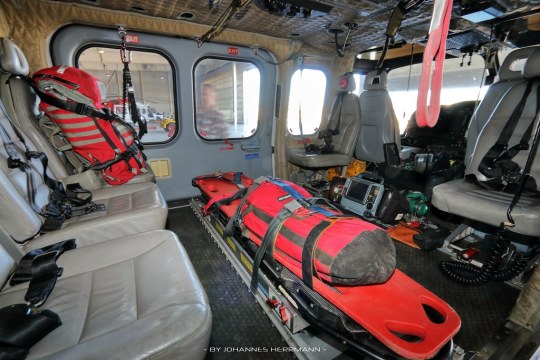
The AW139 is designed to be flown by 2 pilots, flying solo is also possible, but only under VFR (Visual Flight Rules), with an additional certification, which LAFD pilots can and do. To fly it under IFR (Instrument Flight Rules), it always requires 2 pilots according to the FAA last time I checked.

The light helicopter type real!LAFD flies is the Bell 505 Jet Ranger X, a single engine twin-blade made in Canada. It's an relatively new airframe, set to replace the aging Bell 206, which the LAFD used to operate. It's quite a bit smaller than the AW139, it can only fit 1 pilot and 4 passengers.

While it's perfectly capable of carrying a Bambi bucket to assist with aerial firefighting missions, it's mainly used as a training aircraft for new pilots and HLCO (Helicopter Coordinator) when there is a major catastrophe that requires on-the-site air traffic coordination.
These are all brand new and sophisticated aircrafts that a mere TV channel can't get their hands on without a government budget. So for 911!LAFD Air Ops, ABC went to their usual helicopter service company for prop aircrafts.
Helinet Aviation provides all sorts of helicopter services from aerial journalism, medevac, delivery to regular chartering. All the 911!Air Ops scenes in 7x03 and 7x04 are naturally filmed in the Helinet hanger, for convenience's sake, at VNY, just a runway across from real!Air Ops.
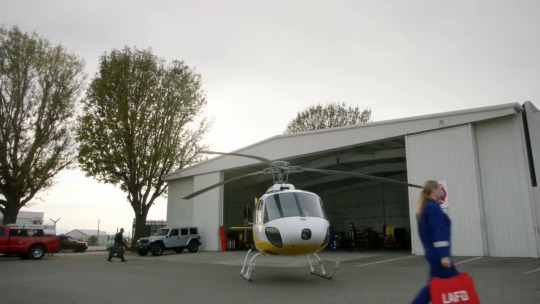
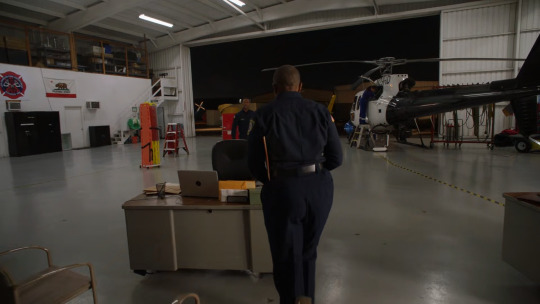
911!Air Ops

Helinet hangar Street View
I believe I've identified all the helicopters shown in 7x03 and 7x04, but let's get the 2 in the background which probably do not belong to 911!Air Ops out of the way:
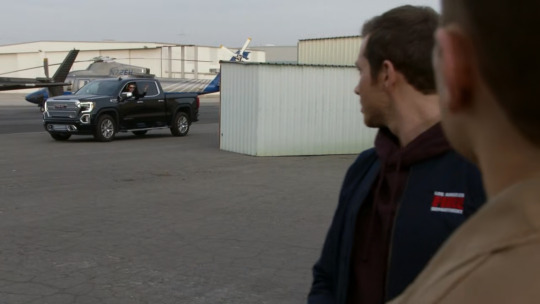
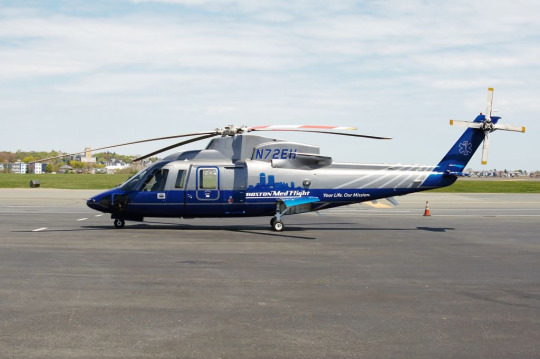
N72EH, a Sikorsky S76C++, still in its Boston MedFlight livery. Sold to Helinet in 2022, possible used as a medevac vehicle currently? Unlikely to have anything to do with 911!Air Ops, probably just happened to be in the background to make it seem like there were many helicopters.

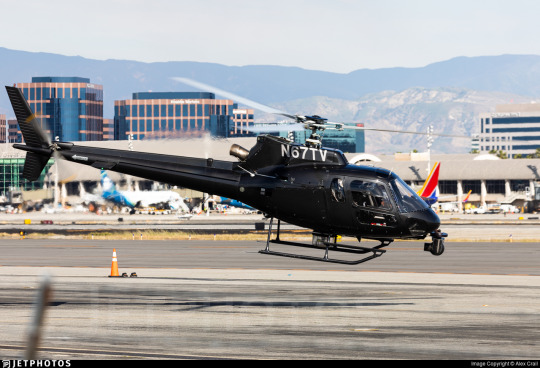
The one Tommy flies Eddit to Vegas in is N67TV, an Eurocopter AS350B2 Écureuil (aka squirrel). No fire department would ever let employees take their expensive equipment out for a joy ride so it's likely that in universe, Tommy rented it from somewhere outside of the station. IRL though, according to this forum post, it's used as a backup helicopter for all its customer news stations, but also any TV or film production purposes outside of journalism.
Now, for the one seen in the hangar, therefore explicitly belonging to 911!LAFD:

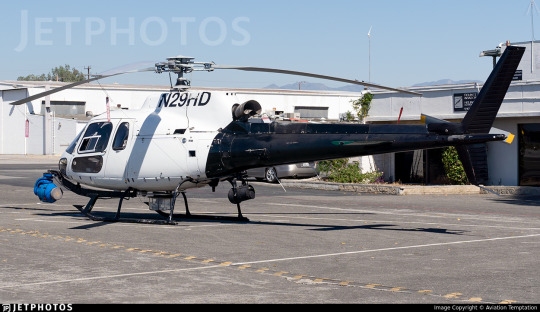
N29HD, also an AS350B2, also a news helicopter. According to this reddit comment, it used to be shared between CBS and FOX, but now it seems to be configured as a dedicated aircraft for ABC7.
The one the who cares gang stole to rescue Bobby and Athena though has a fake registration number on it:
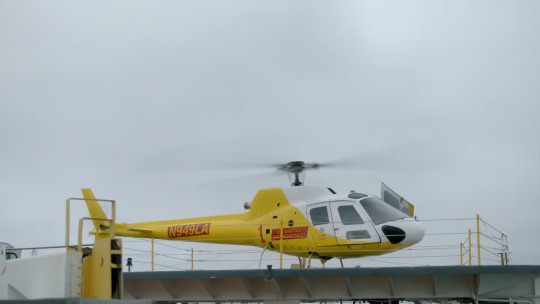
You just have to look up Helinet's fleet, and you will see this is obviously a DHL livery, and it's quite easy to find out that this is actually:
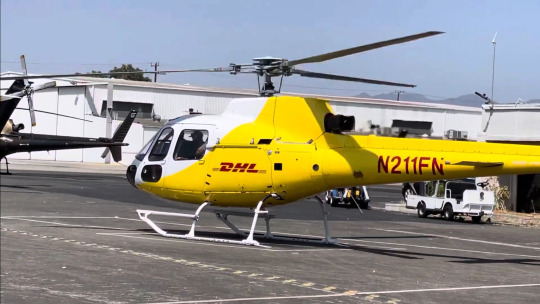
N211FN, an AS350B1 (so an even older variant than the previous two), operated on behalf of DHL for package delivery service.
Don't get me wrong, the AStar (how the AS350 is called in the US) is a versatile and reliable aircraft. It the 4th most produced rotorcraft in the world, someone even managed to land one on top of Mount Everest. But it's kind of small? It can seat only up to 5 passengers with 1 pilot, and there is hardly room left for any gear. There is also no space for stretcher, so anyone they rescue would have to sit upright. It's just not very realistic.
I have no idea what medium duty helicopters 911!Air Ops operate, we're unlikely to see them in the future. There is this Bell 205 in 4x12 Treasure Hunt, but it clearly says L.A County Rescue on the tail.
youtube
Pilots
Real!Air Ops pilots wear beige flight suits, it's the aeromedics who wear blue, and helitac crews wear orange. I'm not complaining too much though, Tommy looks good in blue. (I think the chief pilot wears dark blue, but I'm not sure.)
Helicopter pilots in general usually wear helmets, in case a particularly strong pocket of turbulence slams you against the body of the aircraft, or a bird decide to fly through the windshield into your face, but I get that it gets in the way of the camera, so I'm just gonna enjoy Tommy's beautiful face.
Real!Air Ops pilots work on a 24/48 shift schedule just like any platoon firefighters. Due to the danger of pilot fatigue on aviation safety, they do try to limit their continuous flight time to 6 hours before taking a prolong break.
There are 5 levels of pilots: pilot I (trainee), pilot II (probational), pilot III (full pilot), pilot IV (lead pilot) and pilot V (chief pilot). The chief pilot oversees the entire Air Ops and work on a 10 hour per day, 4 days a week schedule. The rest of the pilots are put into 3 shifts, each shift with a pilot IV, 2 pilot IIIs and 2 trainees/probies, together with 4 aeromedics. (Can't find the most updated version, the lastest one I can get my hands on is from 2022, so good enough?) Therefore Tommy's Bobby would not be a captain, it would be a lead pilot.
I've already explained in detail the timeline of Tommy's career as a firefighting pilot, but here is the short version of it: Once accepted into the LAFD pilot training program, he would have to train with the LAPD for 180 hours then back to the LAFD for 200 hours, that takes around 2 years, and by then he would be a probie. After that, he would have to slowly build up flight hours then train and certify for all types of missions on the medium duty helicopter, that would take another 2-3 years, and after that he would be promoted to a pilot III, which is probably the rank he holds now.
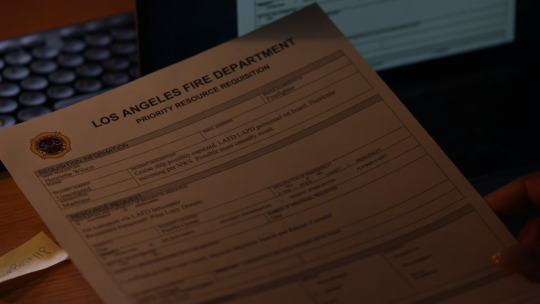
We can see from the form Hen submitted in 7x03 that she initially asked for Lucy as their pilot, as she's forgotten that Tommy also worked there. Fortunately Chimney called Tommy, as Lucy most likely would've still been a probie if not just a trainee.
Melton
I have no idea who he is.
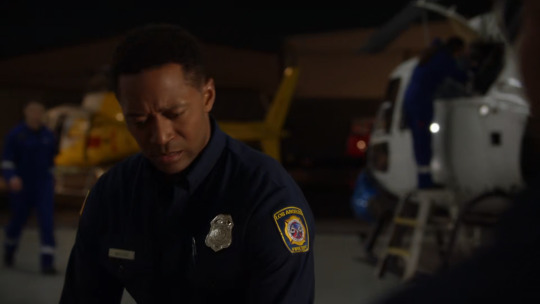
I can sort of see his badge says "firefighter"? At real!Air Ops, everyone wears a flight suit as uniform, so that they can hop into a chopper in an emergency. I don't know what a dude in a regular uniform with the regular LAFD patch on his arm doing there.

Tommy's arm has the Air Ops helicopter patch on it.
Real!Station 114 though do have a crash unit staffed with regular firefighters, maybe Melton is with them? But then, why is he doing with Hen's helicopter requisition?
#911 abc#911 on abc#911 show#911 meta#tommy kinard#tagging the ship for fic writing reasons#bucktommy#tevan#kinley
110 notes
·
View notes
Note
I don't write but I am interested in what you would recommend for writing about preparing for a flight in a light aircraft realistically. Even for drawing. While reading your blog I remembered some story or something describing a scene in the back seat of a small plane like a cessna 172 and I just couldn't imagine any of it well because i know that space is too dang tight.
Also, just out of curiosity
What are some examples of planes that you can instruct in? Are we talkin cessna or piper or beechcraft or?
Hi!
I instruct in the Piper PA-28 series of aircraft, and a basic flight plan is typically done in the few hours preceding a flight, or the night before in the case of an early-morning flight.
Step one is to determine where you want to go, and if the weather will even allow for it to happen. Assuming you're in the USA, aviationweather.gov and 1800wxbrief.com are the two most useful websites for flight planning. This step is a "big picture" glance at the route of flight, and this is when you actually draw your lines on a map to plan out your route.
Once the weather looks okay and your route is planned, the next step is to designate a set of "checkpoints" along your route of flight, be they landmarks on the ground for VFR (visual) flight, or navigation waypoints for IFR (instrument) flight. The purpose of these is not only to remember what to look for, but to help figure out your ETA with some math you'll be doing later in the planning process.
All of these waypoints are written down in a document called a nav log, which is essentially a table describing your route, the waypoints along them, estimated speeds, estimated times, etc. Once all of your waypoints are picked out, you tally up the distances between them (in nautical miles), and make sure that number matches the total distance.
Now, with your route and waypoints, it's time to take a closer look at the weather. Since we already know we'll be clear of any nasty weather, now is the time to focus on one important thing: what the wind is doing.
Using the websites above, we can get a forecast of the wind speed and direction at our desired altitude, which is chosen based on what provides the best tailwind (or least-bad headwind). Our altitude, assuming a VFR flight, follows the hemispherical rule - eastbound flights fly at an odd-thousand altitude plus 500, and westbound flights fly at an even-thousand altitude plus 500. Add the wind speed/direction, as well as the desired altitude, to the nav log.
Now, here's the part where we do the math, and for this, we'll use a special calculator called an E6B. It's a slide rule whose design has been almost unchanged since the Second World War, and it can do unit conversions, course corrections, fuel burn calculations, and much more. What we want right now is the wind correction function - given a desired course, a wind speed, and a wind direction, it can calculate a ground speed (faster with a tailwind, slower with a headwind), as well as a wind correction angle, which is a heading to keep the airplane from being blown off course by the wind.
We need to do a wind calculation for each of our waypoints, adding the wind correction and ground speed to our nav log.
Now that we have our estimated ground speeds at each waypoint, we calculate our estimated time enroute (ETE) between each waypoint, again using the E6B to do so and adding the results to the nav log. Add up the ETEs between each waypoint to get an ETE for the entire route.
After that's done, we'll calculate how much fuel we need. Consult the airplane's manual for a fuel burn measured in gallons per hour (GPH), which is 9.5 GPH for the PA-28. Do the math with the E6B, and you now have your cruising fuel.
Next, climb fuel - for this one, you need to consult the airplane's manual, and follow the directions on a graph to get this number.
Finally, reserve fuel - for a VFR flight during the day, you need enough fuel to cruise to your destination, and then fly at a normal cruising speed thereafter for 30 minutes.
For a VFR flight at night, or an IFR flight, you need 45 extra minutes of fuel, plus any fuel needed to fly to an alternate airport in the case of IFR.
Those are the basic elements of a flight plan, but there's more that pilots are required to familiarize themselves with:
- NOTAMS (notices to air missions; typically concerns airport closures or non-standard procedures)
- Weather information (it's always good to do one more look at the weather, and also obtain a weather briefing for your route of flight)
- Known delays (ground stops, busy airspace, etc)
- Runway lengths at airports of intended use
- Alternative airports to land at if your destination is no longer suitable
- Fuel requirements
- Takeoff and landing performance numbers (can your airplane take off and land within the length of the shortest runway you plan on using?)
- Any other information pertinent to the flight
11 notes
·
View notes
Text
Been seeing a lot of commentary and just blatant misinformation (from both individual posters on social media and the mainstram media themselves) on the DC mid air collision, so I wanted to make a post with some nuance to clear up the situation.
The details of the accident seem pretty straight forward using the ATC recordings but it's important to let the NTSB do their job and publish their own probable cause after an investigation.
First some background on the aircraft involved and what they were doing just prior to the collision.
American Eagle 5342 was a Bombardier CRJ700 operated by American Airlines on an IFR flight from Wichita, Kansas to Ronald Reagan Nat Airport, DC.

When an aircraft flies IFR (Instrument Flight Rules) they make and file a flight plan that includes very specific routes and altitudes to get from one airport to another and they are in constant communication with ATC. Think of it like driving on the highway from one city to another. You use an on ramp (departure procedure) to get out of one city and onto the highway (en route structure and airways), then get off the appropriate exit (approach procedure) to end up in another city.
Different airports will have different approach procedures depending on the runway and the navigation equipment being used. In some cases you can use the approach to one runway to descend down to the airport and then perform a "circling approach" where you break off at a certain altitude and circle around to land at another runway. This is what Flight 5342 was cleared by ATC to do before the collision.

The jet used an approach to runway 1 with a circle to land clearance for runway 33. This meant it made a right turn from the south of the airport at a low altitude before making a left turn to set up for a final straight in leg to runway 33. None of this is unusual for an airliner to do.
The helicopter involved was a US Army UH-60 Black Hawk helicopter under the callsign PAT25 making a routine VFR flight southbound down the Potomac river.

Under VFR (Visual Flight Rules) an aircraft navigates by visual reference to the ground and landmarks, largely or fully independent of ATC guidance. However the helicopter was within the boundaries of Reagan airport's airspace, where they would need to be in communication and radar contact with the control tower. The helicopter was navigating through the airspace along a published helicopter route where they would only need clearance to enter the airspace and then navigate the route themselves.

They were flying along route 1 to route 4 southbound (top left of the chart to bottom center). This route has a published maximum altitude of 200 feet above the ground but ADS-B data shows the helicopter at 400 feet which should have been corrected by the pilots and/or notified by ATC.
So with the helicopter above its required altitude and the jet circling through their flight path a collision would be imminent but still avoidable.
When aircraft are flying near each other in some controlled airspace they will be issued traffic alerts from ATC. This would sound something like "ABC123 Traffic 9 o'clock 4 miles at 1500 report them in sight". At that point you would have a decent idea of where to look and scan for that traffic before replying whether you had them in sight. After you've been notified you'd build and maintain that situational awareness to avoid them.
When the helicopter was notified that the jet was making a circling approach to runway 33 they reported the traffic in sight and requested visual separation, which was approved by ATC. Now it was up to the helicopter to keep the other aircraft in sight and either slow down or alter their flight path slightly to pass around and behind the landing jet.
Again, nothing unusual about that. The problem was the flight was occuring at night where the only way to spot traffic is by their exterior lighting.
I've been on night flights through very busy airspace and seen a long line of airliners on approach to parallel runways and if the lights weren't at different altitudes, I'd have no idea which ones were further or closer to me. At night a plane thats at 10 miles away looks awfully similar to one that is only a mile away.
I believe the accident was primarily caused by the helicopter spotting the wrong aircraft and not noticing the much closer jet circling to land. Behind the CRJ was another flight also on approach to runway 1 that was probably spotted instead.
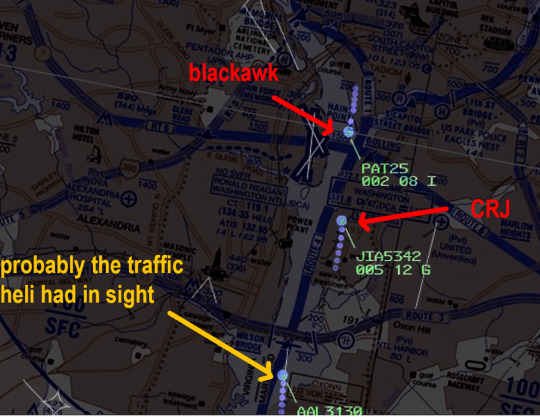
With the helicopter focused on that aircraft and the jet focused on landing their aircraft. To top it off, ATC again asked the helicopter if they had the traffic in sight when they appeared to still be closing, which the helicopter confirmed they did. A few seconds later the mid air collision happened.
I wont assign fault to any one part but I expect the helicopter route chart, ATC guidance, the approaches, and crew training for all parties involved to be revised.
The media on both sides is trying to make a political spectacle for the crash, blaming shit like DEI or the incoming Trump Administration. Ive even seen those demanding to see the "black box" data to somehow prove what caused the accident. The flight data recorder aka "black box" will only tell you that both aircraft were operating normally prior to the accident, and hopefully some crew conversation to glean info about the state of their awareness.
This is the deadliest US air travel accident in nearly 20 years and it sickens me how ignorant nearly all media is when reporting on it.
5 notes
·
View notes
Text
Aviation Meteorology: A Key Subject in DGCA Ground Classes
Aviation Meteorology: A Key Subject in DGCA Ground Classes
Aviation meteorology is the study of weather as it relates to flight safety and efficiency. Pilots must understand how different weather conditions can impact aircraft performance, visibility, and decision-making. DGCA Ground Classes provide in-depth knowledge of meteorological concepts essential for safe flying.
Meteorology Concepts in DGCA Ground Classes
In DGCA Ground Classes, students learn how to read and interpret aviation weather reports such as METARs, TAFs, and SIGMETs. The syllabus also covers cloud types, wind patterns, pressure systems, and temperature variations. This training equips pilots to anticipate and manage weather-related risks during flight planning and operations.

Real-World Application of Meteorological Knowledge
Pilots trained in aviation meteorology are better prepared to make informed decisions when facing adverse weather conditions. DGCA Ground Classes emphasize practical applications, such as route adjustments due to thunderstorms, turbulence avoidance, and pre-flight weather briefing interpretation. Accurate weather assessment reduces the risk of weather-related incidents in both VFR and IFR conditions.
Conclusion
Understanding aviation meteorology is vital for every pilot. DGCA Ground Classes ensure pilots are well-versed in analyzing weather patterns and making safe, timely decisions. For comprehensive training in aviation meteorology and flight safety, visit DGCA Ground Classes.
0 notes
Text
🛫 VFR vs IFR – Know the Difference

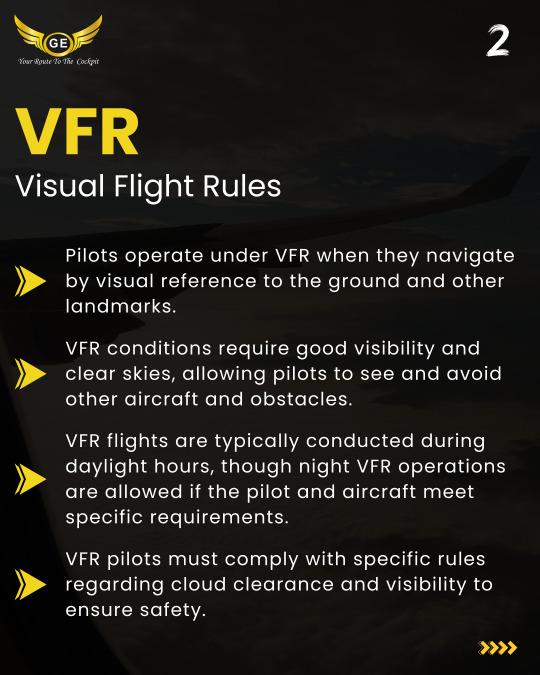

Whether you're an aspiring pilot or an aviation enthusiast, understanding the difference between Visual Flight Rules (VFR) and Instrument Flight Rules (IFR) is essential.
✈️ VFR: Relies on visual cues – great for clear skies and daylight flying.
🛩️ IFR: Depends on instruments and ATC – perfect for poor visibility and structured airspace.
🔍 Stay informed. Fly smart.
💡 Want to know which suits your training goals best? Drop your questions below!
#VFRvsIFR #PilotTraining #AviationBasics #AviationKnowledge #LearnToFly #FlightTraining #DGCAIndia #IFRTraining #AviationIndia #GoldenEpaulettesAviation #FlyWithClarity #AviationFacts #PilotLife #FlightSchoolIndia #StudentPilot
Pilot, Aviation, Career, Scholarships, Training, Success, Future, Dream, Flight, Groundclasses, GoldenEpaulettesAviation, Instructors, Opportunity, Growth, Journey, Education, Guidance, AviationIndia, HowToBecomeAPilot, DgcaGroundClasses
#aviation#dgca#dgca ground classes#pilot training#dgca cpl classes#pilotlife#aircraft#us navy#airplane
0 notes
Text
VFR-On-Top is nonbinary
Special VFR is VFR but it is kinda IFR coded in an unofficial way.
Special VFR is a femboy
1 note
·
View note
Video
youtube
All Israel Will Be Saved--What Did Paul Mean? This Interview Changes Eve...
COMMENTARY:
Jimmy, what Jesus was proposing to do was to reform the sociology of Israel into the separation of church and state of Rome. The Talking Cross is a divine endorsement of the novel social engineering of Rome that ended up with the separation of church and state, the separation between superstition and stoic. Pauline Theiology is modern Isreal without the IDF and Tel Aviv. What Pax Romana offered Israel was the IDF and Tel Aviv. The IDF is the State, It is not Judaism, It is stoic in the manner of the Ilatian Regiment mentioned in Acts 10. Cornelius is stoic. Equity in the context of Manlian discipline of the Legions was defined by a general who beheaded his son for disobeying standing orders to stay at your post and ignore opportunites for single combat, That's what stoic means in terms of Matthew 8: 5 - 13, the authority to which the centurion is submitted, Can you see why all the Roman soldiers discovered they were Christian when they herard about the Talking Cross. Paul refers to the Talking Cross at least 19 times in his Epistles, especially Phillipians, which is obvously an End Zone Celebration after being examined by the Italian Regiment, Paul realizes that. ofa ll the chruches he has spent time with, physically and spiritually, the Roman Chruch of the Italliean regiment was the strongest and his epistels are agranged by the Holy Spirit graphicially in the text like an arrohead pointd at Hebrews. What Jesus was trying to do was to form a republic, In rome, Paul discovers exactly how the Holy Spirit had collaborated with him to bring his thinking to Theophilus, the author of Hebrews, Two things the Romans were interested in was the connection between the Talking Cross and Romans 13:1 - 7 in regards to Manlian Discipline is ascknowleded in Hebrews 13:17. The other things is the harmonization of I think Thessalonians and Ephisians, where he desribes the verticle and horizontal structures of salvationg of the Liberation Gosple of the stoics. The Apostle's Creed is stoic, You don't become stoic: you submit to its equity. The IDF is the consequence of the stoic in Pauline Theology. When you take Hegel out of the Bible, the epistemology of Jesus goes with him. Theologically speaking, you are flying VFR in an IFR condition,
0 notes
Text
AAI Celebrates 78th Independence Day with Patriotic Zeal and Accomplishments

Guwahati: The Airports Authority of India, Regional Headquarters – North Eastern Region (AAI-RHQ-NER), commemorated the 78th Independence Day with a vibrant celebration that embodied the spirit of patriotism and highlighted the region's remarkable progress. M. Raja Kishore, the newly appointed Regional Executive Director (RED) for the North Eastern Region (NER), ceremonially hoisted the National Flag at the newly constructed building complex of the NAI within the Guwahati Airport premises, marking the occasion with great pride and honour. The event was graced by distinguished guests, including Heads of Departments (HODs) and representatives from various organisations, who joined in the festivities to honour the nation’s independence. Adding to the grandeur of the celebration, the Central Industrial Security Force (CISF) presented a prestigious ‘Guard of Honour’ to the RED. The event was infused with patriotic fervour, featuring soul-stirring renditions of patriotic songs and captivating dance performances by children, which resonated deeply with all those in attendance. In his address, M. Raja Kishore highlighted the significant strides made by the NER's airports over the past year. He underscored the substantial development in airport infrastructure, the enhancement of passenger facilitation, and the initiation of several key construction projects. Among the notable achievements, he mentioned the completion and inauguration of the new Terminal Building at Tezu Airport last September, and the successful operationalisation of the extended runway at Dibrugarh Airport. Additionally, he pointed out the upgrade of Hollongi Airport from Visual Flight Rules (VFR) to Instrument Flight Rules (IFR), making it operational in all weather conditions. The RED-NER also provided updates on other critical projects nearing completion, such as the Air Traffic Control (ATC) cum Technical Block at Shillong Airport, which is in its final stages of completion with the commissioning process already underway. Furthermore, the installation and commissioning of Instrument Landing Systems (ILS) at Imphal and Agartala airports were successfully completed, and Dibrugarh Airport has also installed its ILS. He highlighted the commissioning of Doppler Very High Frequency Omni-Directional Range (DVOR) at Imphal Airport and the completion of installation, calibration, and pre-commissioning processes at Dibrugarh Airport. Ongoing projects were also discussed, including the reconfiguration of passenger terminal buildings to enhance capacity at several airports, including Imphal, Jorhat, Shillong, Dimapur, and Silchar. These projects reflect the AAI’s commitment to continuously improving airport infrastructure in the region, aiming to provide world-class facilities to passengers. The RED-NER concluded his speech by expressing heartfelt appreciation for the unwavering dedication and commitment of all AAI officials, attributing the region’s achievements to their diligent efforts. He emphasised that these accomplishments are a testament to the hard work and dedication of the team, and he encouraged everyone to continue striving for excellence in their respective roles. Read the full article
0 notes
Text
Flying the High Seas: An All-Inclusive Handbook of Aircraft Navigation Charts
Aircraft flight charts are essential resources in the aviation industry that guarantee effective and safe navigation. Having a grasp of flight charts will help you better appreciate the difficulties involved in traveling the skies, whether you're an experienced pilot, an aircraft dedicated, or a frequent traveler interested in learning about the complex systems that govern air travel. This blog explores the subject of aircraft flight maps, including their types, history, and vital functions in contemporary aviation.

The Development of Flight Maps for Aircraft
Flight maps have a long history that begins in the early years of aviation. To navigate at first, pilots used simple maps, visual cues, and crude instruments. The necessity for increasingly sophisticated navigational equipment increased as aviation technology developed. An important turning point in the development of flight maps was the introduction of radio navigation aids like the Non-Directional Beacon (NDB) and the VHF Omnidirectional Range (VOR). By giving pilots more precise information about their position and orientation, these tools increased flying efficiency and safety.
The Global Positioning System (GPS) and the introduction of digital technologies have made flight maps considerably more accurate and user-friendly. Pilots can now have complete situational awareness thanks to the sophisticated avionics systems installed in modern airplanes. These systems combine digital maps, GPS data, and real-time meteorological information.
Types of Aircraft Flight Maps
There are many different kinds of aircraft flight maps, and each has a distinct function throughout different flying stages. The main categories of flight maps used in aviation are as follows:
Diagrams for Aircraft: These are detailed maps created especially for use in aviation. They offer details on airports, obstacles, airspace borders, and navigational aids. Sectional charts, en route charts, and terminal area charts are further classifications for aviation charts, each of which is specific to a particular flight phase and altitude.
Charts for Visual Flight Rules:These charts, which are mostly used by pilots operating under visual flight rules, place special emphasis on visible landmarks, natural features, and man-made buildings. VFR charts retain a pilot's visual reference to the ground, which aids in navigation.
Charts for Instrument Flight Rules: These charts are created for use by pilots operating under instrument flight regulations, in which visual cues are not used for navigation but rather instruments. IFR maps contain comprehensive data about instrument approach procedures, navigational aids, and airways.
Visiting Surfaces: These maps, which are often referred to as instrument approach procedures charts, offer comprehensive guidance on how to land at an airport using instruments. Approach plates contain details on airport-specific navigational devices, missed approach protocols, and minimum descent altitudes.
Maps with landscape: Geographical maps offer useful information on topographical characteristics, elevation, and natural obstacles although they are not only used in aviation. These maps are used by pilots to determine routes that guarantee safe altitudes and steer clear of dangerous terrain.
Flight Maps' Function in Modern Aviation
In many facets of contemporary aviation, including pre-flight preparation, in-flight navigation, and post-flight analysis, flight maps are indispensable. Here's a closer examination of their importance:
In advance of The flight Preparation: Pilots perform extensive pre-flight planning, which includes route selection, fuel calculations, and weather checks, before any trip. To identify potential hazards, plan alternate routes in case of an emergency, and select the most efficient and safe path, flight maps are vital instruments in this process.
During Flight Direction: Pilots use flight maps to stay aware of their surroundings and make sure they are headed in the right direction while in flight. Modern aircraft have digital flight displays that combine flight maps, weather data, and real-time GPS data to give pilots a thorough picture of their location and surroundings.
Navigating Altitude: Pilots rely on flight maps to assist them in avoiding objects and terrain. Flight charts help pilots maintain safe altitudes and steer clear of mountains, buildings, and other impediments by giving comprehensive information on elevation and landscape characteristics.
Maintenance of Airports: When flying in restricted airspace, where pilots are required to follow strict routes and altitudes to prevent collisions with other aircraft, flight maps are indispensable. To provide safe and easy navigation across congested airspace, aeronautical charts give information on airspace limits, restricted regions, and air traffic control frequencies.
Machine Methods: Aircraft employ approach plates to perform correct approaches at airports when operating under instrument flight rules. These charts include comprehensive instructions on how to use navigational aids, missed approach procedures, altitude and direction modifications, and final approach and landing aspects.

Flight Charts' Future
Flight charts appear to have a bright future as long as technology keeps improving. The way pilots engage with flight maps is going to change dramatically as augmented reality (AR) and artificial intelligence (AI) are integrated into aviation. Critical flight data can be superimposed using augmented reality (AR) onto the pilot's field of vision, improving situational awareness and lowering cognitive strain. AI is capable of real-time analysis of massive volumes of data, giving pilots predictive insights and maximizing safety and efficiency in flight paths.
Flight map accuracy and dependability will also be increased by the ongoing development of satellite-based navigation systems like the Wide Area Augmentation System (WAAS) and the European Geostationary Navigation Overlay Service (EGNOS).
Conclusion
The use of aircraft flight maps is essential for precise, effective, and safe airborne navigation. The needs of modern aviation have prompted flight maps to change from their simple origins as simple maps and visual aids to the complex digital systems of today. These maps are essential for every stage of flight, whether they are being used for terrain avoidance, in-flight navigation, or pre-flight planning. The future of flight maps promises even higher accuracy, efficiency, and safety as technology develops, improving the whole aviation experience for both pilots and passengers.
0 notes
Quote
着陸復行または着陸復航(ちゃくりくふっこう)とは、VFR、IFRを問わず航空機が着陸もしくはそのための進入の継続を断念し、上昇体制に移ること。ゴーアラウンド(Go-around) とも言われる。 パイロットが自身の判断で行うことも、また、管制官が滑走路又は航空交通の状況等の事由により到着機の進入継続が安全でないと判断される場合に指示を行うこともある。「着陸復航」と記述されることもある。単に「復行」と言った場合には進入復行ではなく着陸復行を指すことが多い。 極端に接地点が奥にいってしまった為にそこから再上昇しても、タッチアンドゴーとは言わずに着陸復行になる。 海軍航空隊ではゴーアラウンド(Go-around)ではなくウェーブ・オフ(Wave off)と呼称する。 近年の旅客機では、オートスロットルを利用して上昇可能な推力までスロットルを動かして加速する一連の手順をTO/GAスイッチ(Takeoff/Go-around switch)を押すだけで自動的に行う機能を搭載している機種もあるが、誤ってスイッチが押され着陸復行モードに移行したことにより空間識失調が引き起こされ墜落した事例もある(アトラス航空3591便墜落事故)。 操作ミスを減らすためオートランド作動中にTO/GAスイッチを押すと着陸モードが解除され、着陸復行モードに移行する。
着陸復行 - Wikipedia
0 notes
Text
Piper Cherokee PA28-180C 1966 N9031J for Sale
Location Marysville, CA (MYV) AIRFRAME: Total Time 4,726 hours (as of 8/1/2023) GROSS WEIGHT: 2400 Empty Weight: 1356 ENGINE: Lycoming O-360-A3A SMOH 2,222 hrs TOH 608 hrs PROP: Nearly new overhauled propeller installed March 2019 Owned since Sept 1997 (26 years of flying VFR and IFR Western US, Canada and Baja) Avionics GPS : Garmin GTN 650 with FLIGHTSTREAM 510…

View On WordPress
0 notes